One of the reasons the students on the Novus International Undergraduate Networking Day were able to take this great tour of the St. Louis facilities at Novus, Pfizer and Monsanto was because of the scholarships they received from the Missouri Colleges Fund, a not-for-profit group of 16 small, private Missouri colleges and universities that work together to acquire resources to help educate students in member private liberal-arts colleges and universities. And the Missouri Colleges Fund was able to help pay for these bright students’ educations because of the generous donations of Novus, Pfizer and Monsanto.
 During the welcome breakfast, President of the Missouri Colleges Fund, Mike Backer, thanked Novus’ VP of Research and Development, Chris Knight, for the company’s continued support of the fund and the students. To show his appreciation, Backer presented Knight with a folder of biographies of each of the students who received money from Novus. As you can see in the picture, Knight was very happy and surprised to receive the folder.
During the welcome breakfast, President of the Missouri Colleges Fund, Mike Backer, thanked Novus’ VP of Research and Development, Chris Knight, for the company’s continued support of the fund and the students. To show his appreciation, Backer presented Knight with a folder of biographies of each of the students who received money from Novus. As you can see in the picture, Knight was very happy and surprised to receive the folder.
The evening before the event, I talked to Backer, and he told me that Novus is giving these students a unique opportunity to see these operations for themselves.
“Novus is giving more than just money. They’re providing an additional learning experience.”
Backer added that it’s not just the education of the students. The public in general needs to know how important it is to fund the sciences in our institutes of higher learning.
“Anytime we can get the word out there for the colleges fund, for independent schools, and to help promote education, it’s a good thing… good for Novus, good for the colleges, good for our economy.”
I know I posted this before, but just in case you missed it, listen to my entire conversation with Mike here: MikeBacker1.mp3
2009 Novus International Undergraduate Networking Day Photo Set

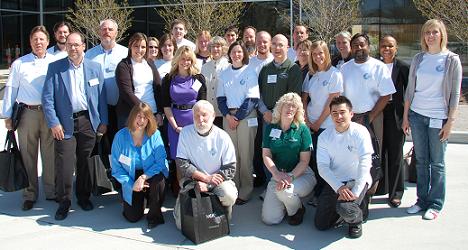
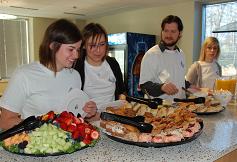 While everyone was able to get fueled up with some tasty pastries and delicious, nutritious fruit and cereal, Vice President of Research & Development for Novus International, Chris Knight, told the group how his company is a one-stop shop for those looking at an agricultural or science career. And he stressed the point that you don’t have to come from a traditional production agriculture background to be a good fit for a company like Novus.
While everyone was able to get fueled up with some tasty pastries and delicious, nutritious fruit and cereal, Vice President of Research & Development for Novus International, Chris Knight, told the group how his company is a one-stop shop for those looking at an agricultural or science career. And he stressed the point that you don’t have to come from a traditional production agriculture background to be a good fit for a company like Novus. 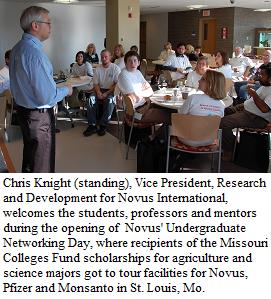 I caught up with Chris, and he told me that they are looking for innovators and people who have a passion for their work.
I caught up with Chris, and he told me that they are looking for innovators and people who have a passion for their work. The opening general session keynote speaker at the NAMA convention was Scott McKain, pictured here in front of the flames of ???? (you supply the description). The flames actually made for a very cool stage background and conversation topic throughout the event.
The opening general session keynote speaker at the NAMA convention was Scott McKain, pictured here in front of the flames of ???? (you supply the description). The flames actually made for a very cool stage background and conversation topic throughout the event.

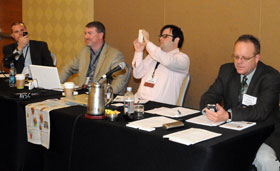 This morning we had a truly awesome session on social media at the NAMA convention. Here’s me and the panel. Yes, we’re shooting video with a Flip, taking a photo with an iPhone, tweeting via iPhone and pounding on a Mac. I like this picture. Some may ask, “What’s wrong with this picture?” I say nothing. We’re just socializing, interacting and engaging. Included in photo are me on the right and panelists: David Coustan, Vice President, Digital, Edelman Digital, Kyle Flaherty, Director of Marketing and Social Media, BreakingPoint Systems, David Brazeal, General Manager, Learfield Data.
This morning we had a truly awesome session on social media at the NAMA convention. Here’s me and the panel. Yes, we’re shooting video with a Flip, taking a photo with an iPhone, tweeting via iPhone and pounding on a Mac. I like this picture. Some may ask, “What’s wrong with this picture?” I say nothing. We’re just socializing, interacting and engaging. Included in photo are me on the right and panelists: David Coustan, Vice President, Digital, Edelman Digital, Kyle Flaherty, Director of Marketing and Social Media, BreakingPoint Systems, David Brazeal, General Manager, Learfield Data.
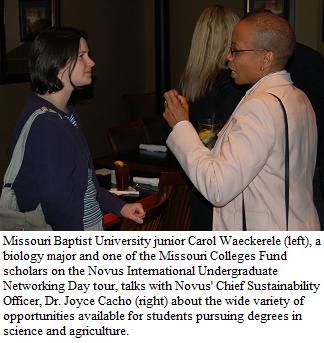 One of those who will be touring around the three companies’ facilities will be Carol Waeckerle, a junior majoring in biology at Missouri Baptist University. She is excited to see all of the different fields these companies offer… so she can know where she wants to work when her schooling is done. Waeckerle says it’s not surprising that a city girl like her would be interested in an agricultural job, especially considering the wide variety of employment available.
One of those who will be touring around the three companies’ facilities will be Carol Waeckerle, a junior majoring in biology at Missouri Baptist University. She is excited to see all of the different fields these companies offer… so she can know where she wants to work when her schooling is done. Waeckerle says it’s not surprising that a city girl like her would be interested in an agricultural job, especially considering the wide variety of employment available. Some of the best and brightest undergrad students in science and agriculture have gathered in St. Louis, Mo. for the Novus International Undergraduate Networking Day… a day when the students, their parents and educational sponsors will get to see firsthand how some of the best agri-businesses in the country operate. They’ll tour Novus’ St. Louis facilities, as well as see the operations at Monsanto and Pfizer.
Some of the best and brightest undergrad students in science and agriculture have gathered in St. Louis, Mo. for the Novus International Undergraduate Networking Day… a day when the students, their parents and educational sponsors will get to see firsthand how some of the best agri-businesses in the country operate. They’ll tour Novus’ St. Louis facilities, as well as see the operations at Monsanto and Pfizer. The students are here, in part, because of the scholarships provided by these companies to the
The students are here, in part, because of the scholarships provided by these companies to the  The NAMA convention is in the home stretch and to unwind a little bit
The NAMA convention is in the home stretch and to unwind a little bit 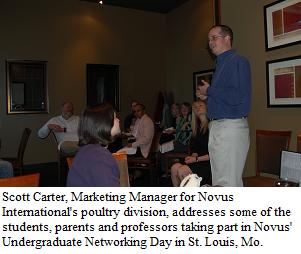 The quote above could easily apply to what Scott Carter, the Market Manager for Novus’s poultry division said to those at tonight’s opening reception before tomorrow’s tour: Less than 5 percent of people know where their food comes from. Scott advised the group of students, parents and sponsors (including several college professors) not to underestimate the reach agriculture has in today’s world and stay open to the variety of opportunities that agri-business holds… even if you don’t come from a purely farming background or education. He says ag needs new ideas on how to solve the world’s challenges of feeding and fueling the ever-growing masses, and those from outside of traditional agriculture can bring in those new ideas.
The quote above could easily apply to what Scott Carter, the Market Manager for Novus’s poultry division said to those at tonight’s opening reception before tomorrow’s tour: Less than 5 percent of people know where their food comes from. Scott advised the group of students, parents and sponsors (including several college professors) not to underestimate the reach agriculture has in today’s world and stay open to the variety of opportunities that agri-business holds… even if you don’t come from a purely farming background or education. He says ag needs new ideas on how to solve the world’s challenges of feeding and fueling the ever-growing masses, and those from outside of traditional agriculture can bring in those new ideas. The NAMA Connection Point trade show is over for 2009 and ZimmComm had a great time.
The NAMA Connection Point trade show is over for 2009 and ZimmComm had a great time.